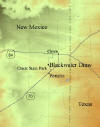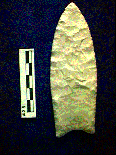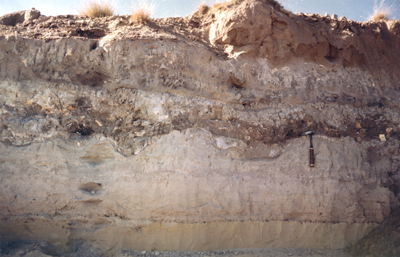|
PREHISTORIC CULTURES OF NORTH AMERICA |
| S.Crouthamel, American Indian Studies/Anthropology,
Palomar College |
Blackwater Draw is a Paleo-Indian complex of sites located near
Portales and Clovis, New Mexico.
 This area is in the Southwestern part of the Plains called the Llano
Estacado or Staked Plains. The site was discovered in 1929 by J.R. Whiteman, who
sent mammoth bone and a Clovis point
This area is in the Southwestern part of the Plains called the Llano
Estacado or Staked Plains. The site was discovered in 1929 by J.R. Whiteman, who
sent mammoth bone and a Clovis point  to the
Smithsonian Institution. In 1932 a Folsom point was discovered by A.W. Anderson
of Clovis , NM. E.B. Howard of the University of Pennsylvania and John Cotter of
the Philadelphia Academy of Natural Sciences did the initial excavation at a location that is referred to as Blackwater Draw
Locality #1. Unfortunately,
gravel mining was conducted at this site from 1932 -1978 and did considerable
damage to the various prehistoric camp sites and butchering sites located
in the area. In 1978 Eastern New Mexico University was able to purchase 157
acres and preserve some of the sites. Here is a summary of excavation at Blackwater Draw:
to the
Smithsonian Institution. In 1932 a Folsom point was discovered by A.W. Anderson
of Clovis , NM. E.B. Howard of the University of Pennsylvania and John Cotter of
the Philadelphia Academy of Natural Sciences did the initial excavation at a location that is referred to as Blackwater Draw
Locality #1. Unfortunately,
gravel mining was conducted at this site from 1932 -1978 and did considerable
damage to the various prehistoric camp sites and butchering sites located
in the area. In 1978 Eastern New Mexico University was able to purchase 157
acres and preserve some of the sites. Here is a summary of excavation at Blackwater Draw:
| 1929 |
J. R. Whitman |
Antiquarian/pothunter |
| 1932 |
A.W. Anderson |
Antiquarian/pothunter |
| 1932-37 |
E.B. Howard/John Cotter |
U. of Pennsylvania/Philadelphia Academy of Natural Sciences;
Carnegie Institution of Washington |
| 1949-50 |
E.H. Sellards/G.L. Evans |
Texas Memorial Museum, U. of Texas, Austin |
| 1950-1963 |
E.H. Sellards;F. Wendorf; A.E. Dittert;A.J. Jelinek |
Eastern New Mexico University (ENMU); El Llano
Archaeological Society |
| 1964- |
George Agogino/students |
ENMU; including land purchase 1978 |
| 1969- |
D. Stanford/V. Haynes |
Smithsonian Inst./U. of Arizona |
| 1988- |
J. Montgomery/J. Dickenson |
curators; Blackwater Draw Museum |
Initially, Blackwater Draw revealed evidence of the Paleo-Indian tradition
referred to as Clovis that was a killsite that included weapons and
tools
associated with the killing and butchering of mammoths. Later, excavation
revealed strata with Folsom and Plano (Portales) tools associated with ancient
and modern bison. Further, camp sites and a well were discovered. Also, Archaic
and later cultures even occupied the area.
 A
A
| Level(top F/G) |
Strata |
Date/Culture |
|
F/G |
Jointed Sand |
4,500/Archaic-Recent |
|
E |
Silt |
8,500-4900/Plano |
| D |
Blue Sand |
10,400/ Folsom |
| C |
Brown Sand Wedge |
11,500 |
| B |
Gray Sand |
13, 000+/Clovis |
| A |
Gravel |
,15,000 |
It is clear that this desert region was a much moister environment with a
lake and water sources that supported conifers (flora) and Pleistocene megafauna.
| FAUNA B |
FLORA B |
| Columbian mammoth |
spruce |
| camel |
pine |
| tapir |
|
| ground sloth |
|
| dire wolf |
|
| short faced bear |
|
| saber toothed cat |
|
| horse |
|
| ancient bison |
|
| FAUNA D |
FLORA D |
| ancient bison |
|
| turtle (terrapin) |
|
| FAUNA E |
FLORA E |
| modern bison |
|
| antelope |
|
Blackwater Draw is valuable primarily because of the complete sequence
from Clovis through Archaic. The data of climate, geology, flora/fauna and
cultural activity gives a good look at cultural change in an area that seems
rather bleak today, but was once a lush lake/forest region of the North American
Plains.
Since 1940 with John Cotter there have been many attempts to preserve
Blackwater Draw.
In 1969 the
Blackwater Draw Museum was opened near Portales, NM. In 1978 ENMU was able to
purchase some of the site. In 1982 Blackwater Draw was put on the National
Register of Historic Places and later became a National Historic Landmark. In
1991 the site,
Blackwater Locality No. 1 was open to the public.
References
Copyright © S.J. Crouthamel
 This area is in the Southwestern part of the Plains called the Llano
Estacado or Staked Plains. The site was discovered in 1929 by J.R. Whiteman, who
sent mammoth bone and a Clovis point
This area is in the Southwestern part of the Plains called the Llano
Estacado or Staked Plains. The site was discovered in 1929 by J.R. Whiteman, who
sent mammoth bone and a Clovis point  to the
Smithsonian Institution. In 1932 a Folsom point was discovered by A.W. Anderson
of Clovis , NM. E.B. Howard of the University of Pennsylvania and John Cotter of
the Philadelphia Academy of Natural Sciences did the initial excavation at a location that is referred to as Blackwater Draw
Locality #1. Unfortunately,
gravel mining was conducted at this site from 1932 -1978 and did considerable
damage to the various prehistoric camp sites and butchering sites located
in the area. In 1978 Eastern New Mexico University was able to purchase 157
acres and preserve some of the sites. Here is a summary of excavation at Blackwater Draw:
to the
Smithsonian Institution. In 1932 a Folsom point was discovered by A.W. Anderson
of Clovis , NM. E.B. Howard of the University of Pennsylvania and John Cotter of
the Philadelphia Academy of Natural Sciences did the initial excavation at a location that is referred to as Blackwater Draw
Locality #1. Unfortunately,
gravel mining was conducted at this site from 1932 -1978 and did considerable
damage to the various prehistoric camp sites and butchering sites located
in the area. In 1978 Eastern New Mexico University was able to purchase 157
acres and preserve some of the sites. Here is a summary of excavation at Blackwater Draw: A
A